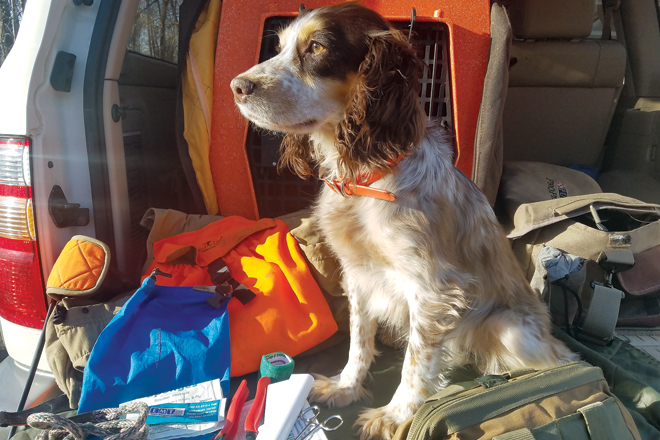Be your bird dog’s first responder and ambulance
By Anthony Hauck
“The two happiest days in a bird dog owner’s life: the day you buy the puppy, and the day they get through a hunt without injury.” - Anonymous
If you’re reading this story after an injury-riddled bird hunting campaign, that take on the old boat owners’ joke is not all that funny. I know because I’ve been there: those trips – and full seasons, in fact – when you feel less like a hunting companion and more like full-time medical staff.
Unfortunately, this is the price we pay to own, train and hunt with our incredible bird dog athletes. The field environment simply has too many variables, and accidents are inevitable. And if you own multiple bird dogs, like me, you know all too well the “injury bug” has a nasty habit of being contagious.
My spaniels have encountered almost all the typical field-care fare, including barbed wire lacerations and bee stings. There have been more emergencies than I care to count, when skin has been stapled and bleeding stopped as time purchased for travel to professional veterinary care.
Four out of five injuries for my bird dog brace have been related to barbed wire. Standing fence poses a risk to any running dog, and pheasant country is home to enough downed and covered barbed wire to circle the globe a few times over. Sharp-edged cattails, logs and sticks can inflict just as much damage, but this merely scratches the surface of what can go awry afield.
 Photo by Anthony Hauck
Photo by Anthony Hauck
Carrying an entire vet office of supplies in the field isn’t an option, but bringing nothing is bird dog negligence. Solution? Break the emergency response down into two categories and two respective “carry kits”: One for what happens in the field, and the other for what happens back at the truck.
The field carry kit helps you act as a first responder on the scene. These items, carried without fail in your vest or coat, enable you to work triage -- and maybe even save your dog’s life. Back at the truck, your “ambulance,” is another kit containing items to help get an injured dog further stabilized until arriving at the vet.
CARRY KIT
This light and lean field kit is efficient and effective. It gets the job done but isn’t so burdensome that you can’t or won’t carry it. Items are packed in an easily opened dry bag and stashed in the back storage pouch of my Browning Bird’n Lite vest (most newer, technical-style vests have such features). The exceptions are the slip lead and cutters, which I keep for even quicker access in one of my front vest pockets.
Slip Lead - Primarily for controlling an injured or panicking dog; also for conibear trap removal.
EMT Gel - A must-carry for reducing bleeding, it’s called “first aid kit in a tube” for good reason.
Gauze Bandage Material, Tape and Vet Wrap - For initial wound treatment.
Medical Stapler - To close larger cuts and/or deeper gashes. Make sure severe bleeding has been stopped before using.
Hemostat - For pulling porcupine quills, thorns, cactus and other embedded objects.
Multitool - Make sure it includes a scissors for cutting bandage and tape.
Cable Cutters - Adds a little weight, but worth it in the event of a snare trap encounter.
Dog Booties - To temporarily cover a bandaged pad/paw injury.
Benadryl Tablets - Administer in the event of allergic reactions from plants, bites or stings.
Emergency Blanket - No-weight carry on hand for hypothermic or in-shock dogs.
Latex Gloves – For some sanitation as you treat wounds.
TRUCK KIT
With space less of a concern, the complete truck kit resides in the back of my truck by the kennel. Like the field kit, accessibility applies: Don’t tuck or stow your kit where it takes real work to get to it.
Gun Dog First Aid Kit - There are numerous prepackaged, dog-oriented first aid kits on the market; or look up their contents online and assemble yours to match. There is crossover with the contents of the field kit, but much more of everything, including cold packs for muscle or joint injuries and hydrogen peroxide for cleaning wounds. With dozens of items, it’s important to actually open the kit, familiarize with what’s inside and know each item’s purpose.
Saline Eye Wash - Use after every hunt to flush seeds and other foreign objects from pup’s eyes.
Ear Cleaning Solution - Ears are the forgotten dog body part. A good cleaning following the hunt can dislodge foreign objects and prevent buildup and problems down the road.
Extra Field Safety Vest
Dry Towels
Extra Field Kit Items - Supplies in your carry kit can be depleted over the season, so set your inventory number at two and you’ll always have an extra on hand.
Area Vet Listing – When on a trip, look up area veterinarians and have their numbers and addresses loaded in your phone.
Anthony Hauck occasionally operates an infirmary for his English cocker spaniels Sprig, Smidge and Ruth. He lives in St. Paul, Minnesota.
This story originally appeared in the 2020 Summer Issue of the Pheasants Forever Journal
. If you enjoyed it and would like to the the first to read more great upland content like this, become a Pheasants Forever member today!